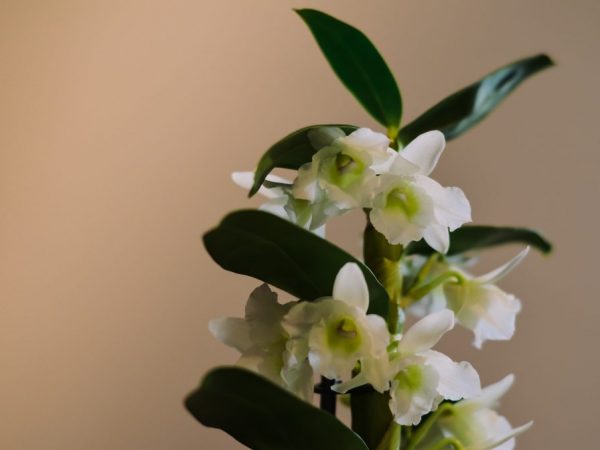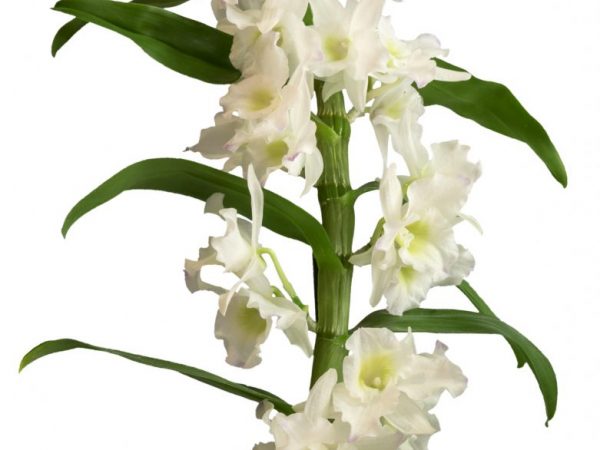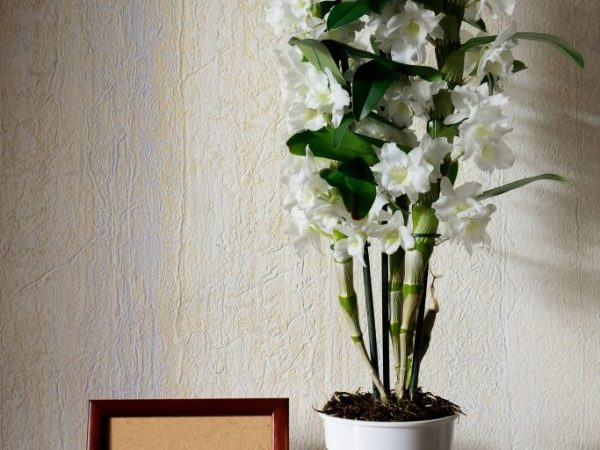Description of the plant Dendrobium Nobile and care for it
Such a charming plant as dendrobium nobile cannot but conquer with its decorativeness and grace. Therefore, this exotic flower is a favorite of many gardeners. Today we will tell you how to propagate, transplant dendrobium nobile at home, and which flower needs care.
- Description
- Care features
- Temperature regime
- Illumination
- Watering
- Humidity
- Top dressing
- Caring for blooming specimens
- Features of care after flowering
- Transplant rules
- Reproduction methods
- Cuttings
- Division of the uterine bush
- Diseases
- Fusarium wilting
- Sticky drops on foliage
- Pests
- Difficulties in growing
- Best and new varieties
- Conclusion

Description of the plant Dendrobium Nobile and care for it
Description
It is a perennial herb of the Orchid family. In its natural environment, this flower grows on a tree, hence the name "dendrobium", which means "living on a tree".
The homeland of this exotic plant is the tropical zones of Japan, the Philippines, Australia, Oceania, China and New Zealand.
In nature, there are more than 1000 varieties, which differ in color of petals, leaves, flowering time and location of flower buds.
Care features
Growing this orchid variety is not an easy task and will require some skill and knowledge from you. To grow a healthy and decorative flowering plant, it is important to know how to properly care for it.
Temperature regime
At home, thermophilic species of dendrobium nobile orchid need a moderate temperature regime:
- in summer during the daytime - 2-25 °, at night - 15-20 °;
- in winter, during the day - within 20 °, at night - not lower than 17 °.
For cold-resistant varieties, a different temperature regime is suitable:
- In summer, during the daytime - 15-18 °, at night - about 13 °;
- in winter, during the day - about 11 °, at night - about 9 °.
Caring for dendrobium nobile is a prerequisite for abundant and colorful flowering.
Illumination
Among all the varieties of the Orchid family, this species is especially fond of good lighting. For full growth, development and flowering, dendrobium nobile requires 12-hour daylight hours. It is important to provide protection from direct sunlight, otherwise the delicate leaves and petals of the plants will get burned.
In the summertime, indoor plants can be taken outside - in the garden or on the balcony. In winter, to provide 12-hour daylight hours, the plants are supplemented with artificial light using LED or fluorescent lamps.
Watering
Given that this flower comes from the tropics, it needs to provide similar growing conditions at home. During the warmer months, dendrobium nobile requires frequent but moderate watering to eliminate the risk of root rot. During the dormant period, when the plant stops blooming, the soil is rarely moistened - once a month.
Watering is carried out with warm, settled water, since this plant has very delicate and fragile roots. When watering with cold water, the root system is supercooled and the plants begin to ache.
Humidity
The optimum moisture level for dendrobium nobile is 55-80%. It is very easy to achieve such indicators at home. In summer, plants should be taken out into fresh air and sprayed with a spray bottle. In winter, during the dormant period, the pot with the plant is placed on a tray of damp gravel.
Top dressing
Home care for the dendrobium nobile orchid involves regular feeding. In this case, it is recommended to exclude all experiments with self-preparation of the nutrient mixture or solution. Since this plant has very delicate roots and in case of an excess of nutrients, they can get severe burns. It is not always possible to reanimate a plant that has been burned with convenience.
Liquid complex fertilizers are used for the dendrobium nobile orchid. The first feeding is done when the plants are just starting to bloom. The second and subsequent meals are carried out every 3 weeks. In the process, watering and feeding of dendrobium nobile is combined in order to eliminate the risk of burning the roots.
The concentration of feeding for this plant is taken two times less than what is written in the instructions. Because a highly concentrated fertilizer can destroy the roots of the plant.
It is recommended to feed warm-loving species and varieties with phosphorus-potassium preparations once a month, even during the dormant period in winter. Such plants will smell better and bloom more profusely.
Cold-resistant species are fertilized with nitrogen-containing preparations in order to stimulate the growth of green mass.
Caring for blooming specimens

The plant blooms for a very long time
Each dendrobium blooms at different times of the year and lasts from 8 to 12 weeks. Taking care of a flowering specimen is not difficult, the main thing is to take into account some rules:
- When preparing plants for such an important stage, it is necessary to ensure a sharp temperature drop - by 6-7 ° both during the day and at night. In nature, this is a natural phenomenon, so at home flower growers also try to reproduce it.
- They stop watering the plant for a while to make it bloom and grow a new shoot with roots. Then watering resumes. As soon as the new stem reaches the height of the old pseudobulbs, the plant again stops watering and the temperature is lowered to 12 °. Do not water until it releases flower buds. Otherwise, instead of flowers, the plant will acquire children.
Such care for the dendrobium nobile orchid during the flowering period is carried out in the winter.
Features of care after flowering
The dendrobium nobile flower, which has ceased to bloom, is gradually stopped to water. The peduncle is cut off, and the pot with the plant is transferred to a cool and dark place. During this period, he begins a phase of rest. In such conditions, he will rest and prepare for a new flowering.
Under natural conditions, such a flower does not have a dormant phase - it constantly grows leaves, shoots or grows overgrown with children. In our latitudes in the winter season, the days are short (dawn and dark early). Therefore, the plant can hibernate and stop growing altogether. To prevent this, he needs to provide a full daylight hours. This will require artificial lighting. The lamp is installed at a distance of 0.5 m from the flowerpot and is turned on in the morning and evening hours.
Transplant rules
Dendrobium nobile orchid does not tolerate the transplant procedure well. But once every 3 years, the plant becomes cramped in the old container and it just needs to be transplanted.
The transplantation of varieties that bloom in the fall is carried out with the beginning of the growth of young shoots. Spring-blooming species are transplanted after they have completely bloomed.
The plant is transplanted into a container 2-3 cm deeper than the previous one. To do this, you can use a plastic flowerpot or a clay pot. Moisten well before transplanting.
2-3 pebbles are placed on the bottom of the container, which will ensure the stability of the flowerpot.Then a drainage layer is laid from pieces of foam or expanded clay. A large-scale bark is laid on top - 2 cm. And then I transplant the dendrobium nobile by the method of transshipment of an earthen coma. A new store-bought substrate is added on top. The nutrient mixture is composed of coconut chips, pine bark, charcoal and sphagnum moss.
Reproduction methods
There are two ways to grow indoor flowers of this variety at home. Let's consider each method in detail.
Cuttings
As practice shows, propagation by cuttings of dendrobium nobile has a positive success. To obtain a cutting, you must choose a healthy and strong pseudobulb from the plant. Separate it from the mother plant and cut into cuttings 10 cm long. The cut of each cut must be processed. This will prevent infection and disease development in future plants.
Cuttings are placed in a transparent plastic bag with moistened sphagnum moss (2 shoots per bag). Then the bags are tightly closed and stored at room temperature (22-24 °) under diffused daylight. They need to be ventilated and watched daily so that they do not dry out. If necessary, sphagnum moss can be sprayed with a spray bottle.
Subject to all storage rules, after about 3 weeks, the shoots will release the first roots. After that, they can be planted in new pots using the same substrate as when transplanting.
Propagation by cuttings makes it possible to get a new plant, which will release the first flower buds 2-3 years after planting.
Division of the uterine bush
Reproduction by children is carried out after the plant has faded - during transplantation. The root system is removed from the pot, the roots are unraveled. Cut off the part that is difficult to untangle. It is divided into several parts. Each delenka must have at least one sprout and 2 bulbs. Places of cuts are sprinkled with wood ash and greased with garden pitch.
Delenki must be planted separately in a nutritious and versatile substrate specially designed for indoor orchids.
Diseases

Only with proper care does the flower bloom
Due to improper care, these indoor flowers are often sick and attacked by harmful insects.
Fusarium wilting
The most dangerous and widespread disease is fusarium. It is caused by a fungal infection. Parasitic microbes penetrate deep into the tissues of the leaves and stems of plants, affecting the vascular system. As a result, the plant begins to wither sharply, wither and die.
The reasons for the appearance of the causative agent of the disease:
- saline soil;
- frequent waterlogging of the soil;
- watering with cold water;
- the increased content of peat in the soil contributes to the development of pathogenic microflora, including the fungus.
The affected flower is quarantined. Resuscitation is carried out as follows: decayed and withered parts are cut off with a knife and treated with iodine or brilliant green. After that, a general treatment of the plant from the fungus with the drug Fundazol or Benomil is performed.
Sticky drops on foliage
The reasons for the appearance of sticky droplets on plants can be different:
- not regular watering;
- an excess of nutrients in the soil;
- self-defense against harmful insects.
There is another reason why sticky drops appear on orchid leaves - it is possible that this is a product of the vital activity of parasites. If a molting moth sticks to such velcro, the appearance of such a disease as powdery mildew cannot be avoided.
First, a light powdery bloom will appear on the foliage, then the leaves turn black. Plants infected with powdery mildew are treated with insecticides - Aktellik or Aktara.
Pests
In addition to diseases, this indoor flower also has pests that can not only slow down growth, prevent flowering, but also lead to the death of an indoor flower:
- Thrips. First, the upper, then the lower side of the leaves are affected.The foliage infected with thrips becomes grayish or silvery. If you do not take timely measures, the leaves completely fall off. For treatment, insecticides are used.
- Shield. These are insects that resemble brown plaques. They settle on the surface of leaves, dig into their tissues and suck out juices. First, the foliage turns yellow, then dries and crumbles. Treatment is carried out with Actellik's solution and soapy water.
- whitefly. The microscopic moth, which settles on the underside of the leaves, also lays eggs there. Parasites suck the juice from the leaves of plants, as a result, the leaf turns yellow, then blackens, dries up and falls off.
Difficulties in growing
Often the cause of the appearance of diseases and parasites on this plant is illiterate and untimely care:
- the tips of the leaves turn yellow due to an excess of sunlight or overfeeding with fertilizers;
- wilting and shedding of leaves caused by excessive watering or lack of daylight;
- watering with cold water leads to rotting of the root system and the development of a disease - root rot;
- from a lack of nutrients, the flowers stop growing and stop blooming.
Best and new varieties
Currently, the dendrobium nobile orchid has several decorative and flowering varieties that have become very popular among flower growers:
- Kumiko. This is a hybrid species, about 12-13 cm high. The leaves are leathery, dark green in color, pseudo-fudge trunks. Up to 10 flowers are located on one peduncle. The petals are snow-white with a pale pink edging. With good care, it blooms profusely and for a long time (about 12 weeks).
- Irene smilie. Hybrid plant with fleshy pseudobulb stems and thick leathery foliage. The height of the flower is about 50 cm. Several flower buds are formed on each flower branch. The flowers are white-lilac, the throat is yellow. Thinning a pleasant aroma. It blooms once a year, duration - 12 weeks.
- Apollo. Tall hybrid, reaching 70 cm in height. Leaves are dense, dark green, leathery. Pseudobulb trunks are fleshy. It blooms profusely with white flowers with a yellow throat. Produces several peduncles. About 10 flower buds are formed on one flower branch. The flowering period is 10-12 weeks. It blooms once a year.
- Orange or orange. Tall hybrid plant - 55 cm in height. With good care, it produces up to 3 peduncles. The flowers are yellow or orange. Flowering occurs once a year and lasts 8-10 weeks.
- Noble. One of the most beautiful exotic species with white flowers and purple edging on the petals. The trunks are massive pseudobulbs, the leaves are green, leathery. Plant height - 50-55 cm. Produces from 1 to 3 peduncles. With good care, it can bloom 2-3 times a year.
Conclusion
With good care of dendrobium nobile at home, the plant pleases with its decorative foliage, flowering, and also thinns its pleasant aroma.


